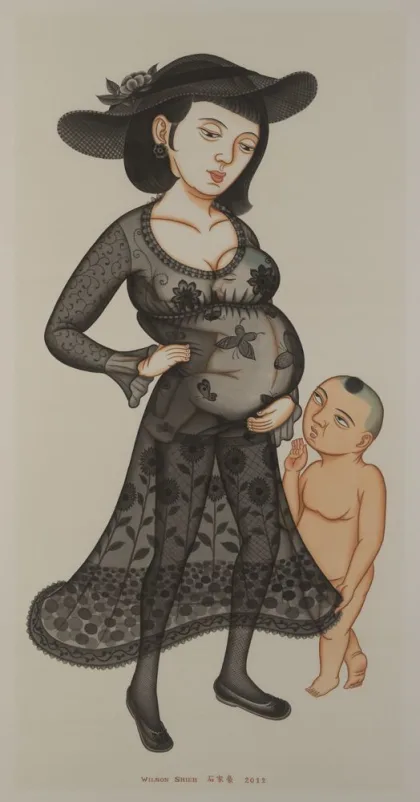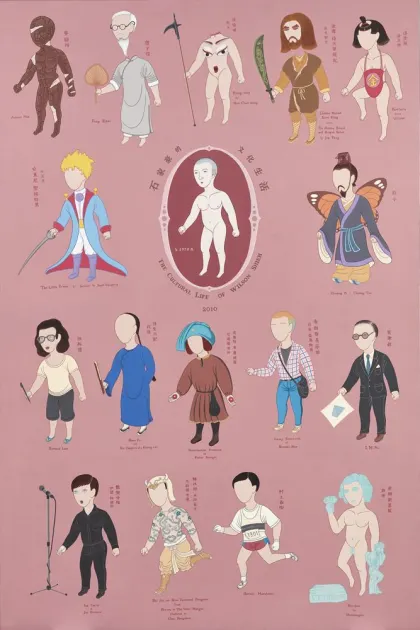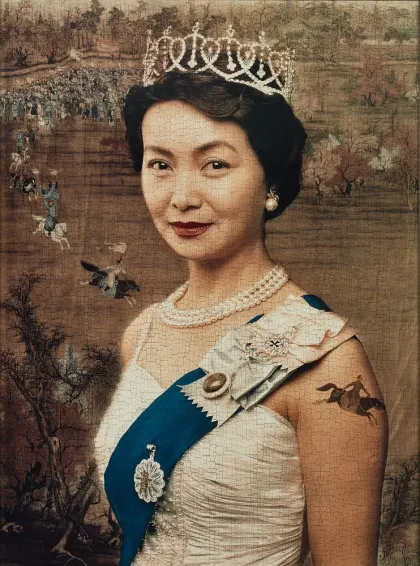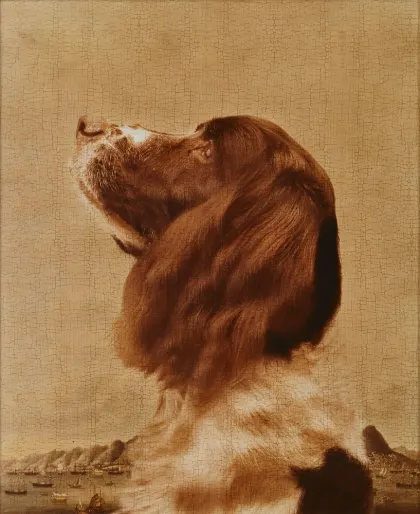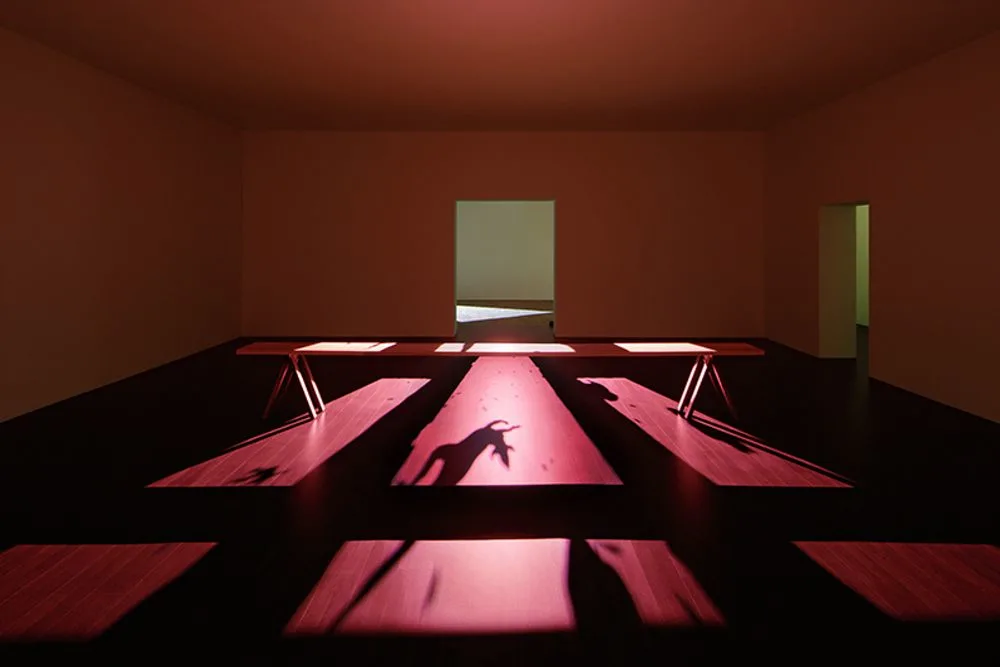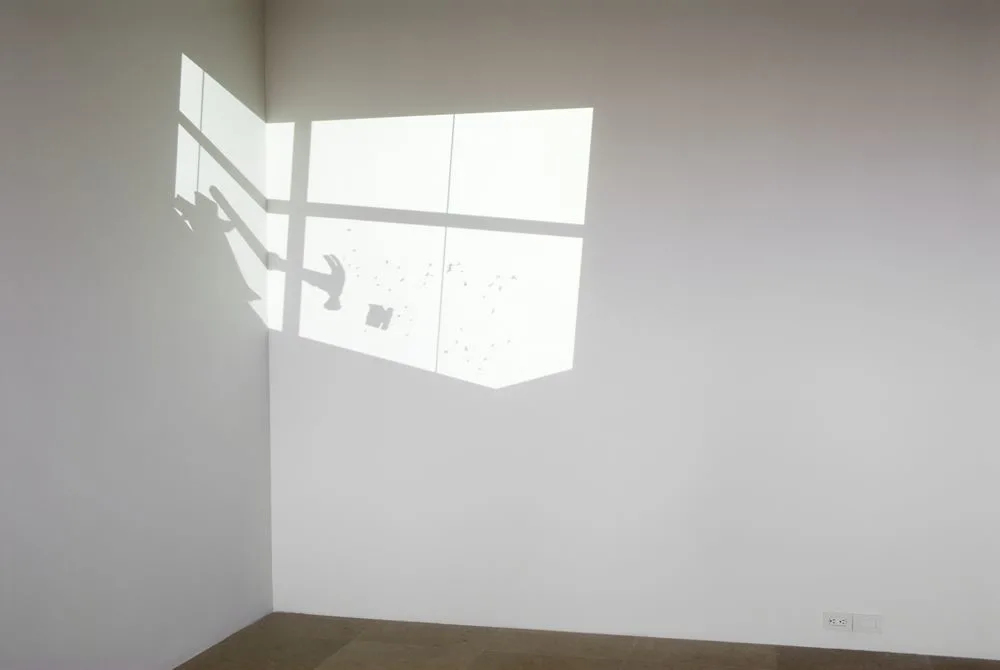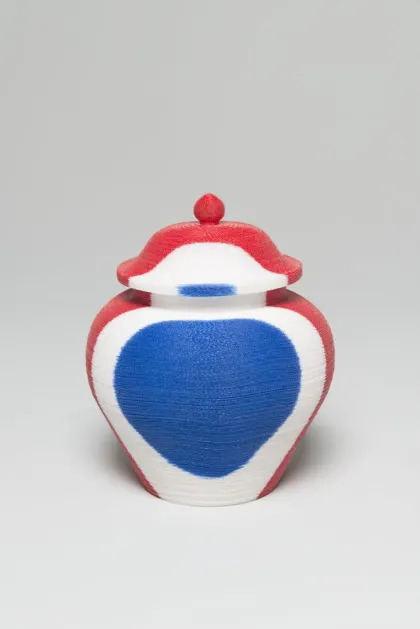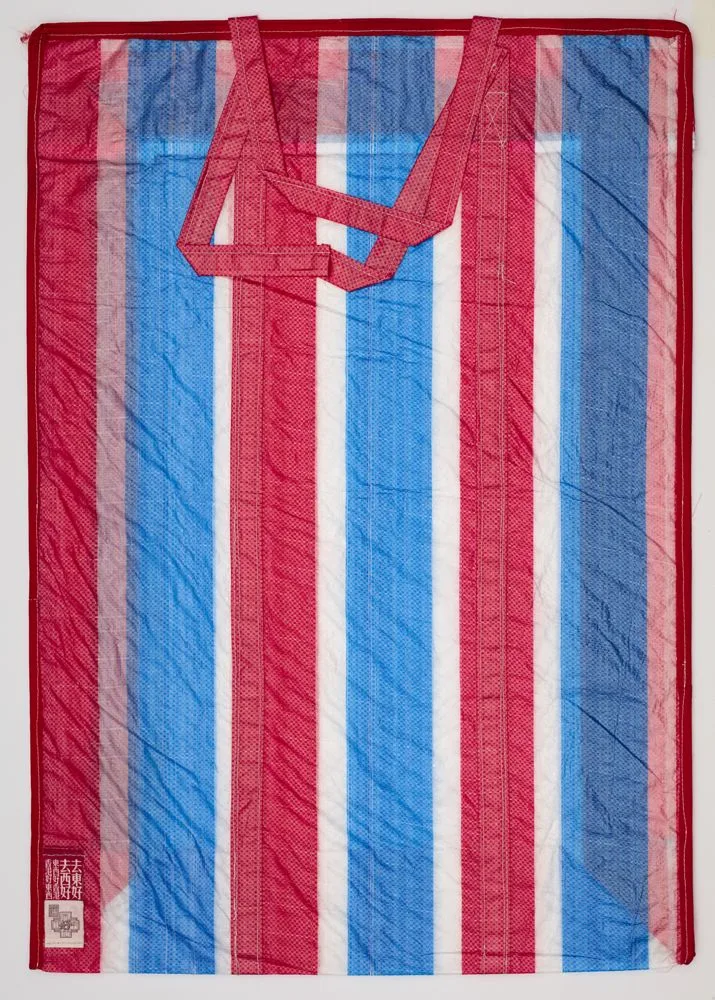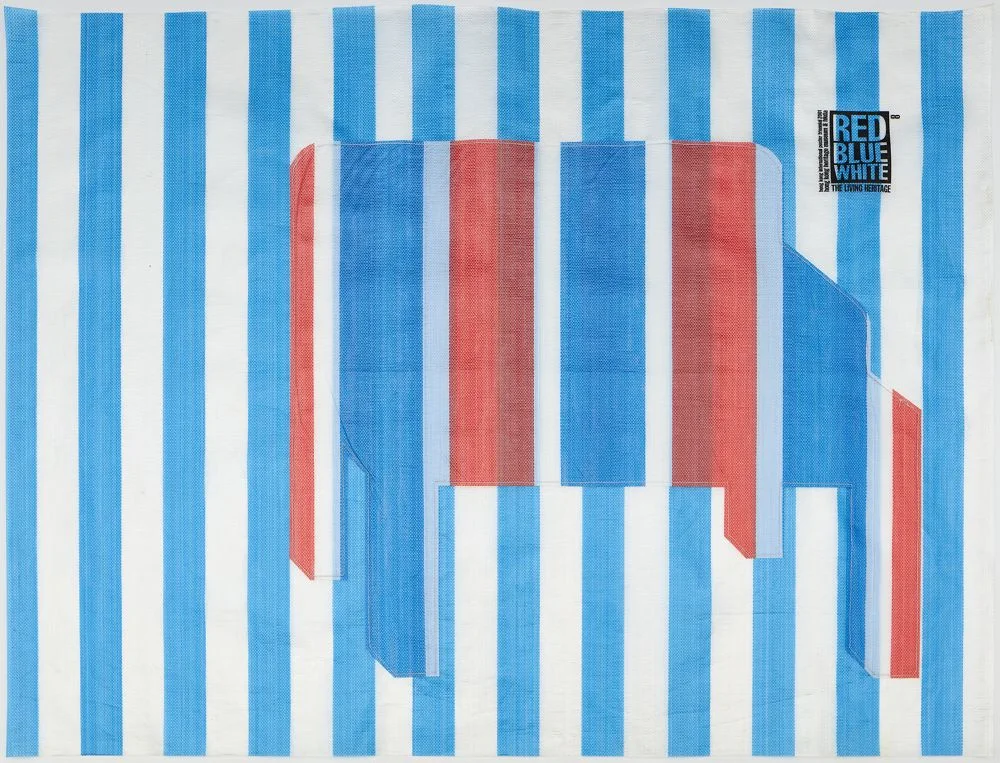by Anthony Brienza
LE M+ MUSEUM, LUMIÈRE SUR LES ARTISTES HONGKONGAIS CONTEMPORAINS
Initialement prévue en 2017, l’ouverture au public du M+ Museum de Hong-Kong a finalement eu lieu le vendredi 12 novembre 2021 au cœur du West Kowloon District. Véritable évènement dans le monde de l’art contemporain, ce nouveau musée incarne pleinement l’ambition hongkongaise de concurrencer les plus grandes institutions occidentales aux moyens d’une faramineuse entreprise axée principalement sur l’éducation et l’innovation. Considéré comme étant le premier musée du continent exclusivement dédié à la mise en valeur d’un patrimoine visuel asiatique contemporain, le M+ détonne tant par l’importance de sa collection que par son sensationnalisme architectural. Ce sont au total 33 galeries et 17.000m2 d’espaces d’exposition pensés par l’agence d’architecture suisse Herzog & De Meuron qui sont agencés afin d’accueillir plus de 1500 œuvres à travers les six premières expositions inaugurales.
“Notre ambition était de créer un nouveau type de musée, capable de refléter singulièrement le temps et l’espace de notre époque. Un musée qui s’appuierait sur l’équilibre historique caractéristique de Hong-Kong, entre le local et l’international afin de constituer une voie supplémentaire d’innovation pour l’Asie du XXIème siècle.” extrait du symposium “What Do Collections Mean to Museums?”, a collaboration with the Mori Art Museum, Tokyo, through the global partnership initiative M+ International.
La constitution de cette collection historique émane en effet d’une perspective tant hongkongaise que globale, où un vaste corpus artistique composé de peintures, sculptures, mobiliers, productions numériques, dessins d’architectures, designs graphiques et installations cohabitent afin de composer un récit continental de l’art depuis le début des années 1950. Néanmoins, ce sont les artistes contemporains originaires de Hong-Kong qui demeurent priorisés au sein des collections. En effet, la ville du delta de la Rivière des Perles constitue un véritable cadre d’interprétation au musée et permet de naturellement mettre en valeur des artistes contemporains locaux. L’occasion pour ACA project de revenir sur certains de ces grands créateurs faisant aujourd’hui l’identité visuelle de Hong-Kong et du tout nouveau M+ Museum.
THE M+ MUSEUM, HIGHLIGHT ON HONGKONG CONTEMPORARY ARTISTS
Originally scheduled for 2017, the M+ Museum in Hong Kong was finally opened to the public on Friday, November 12, 2021 in the heart of the West Kowloon District. A true event in the world of contemporary art, this new museum fully embodies Hong Kong’s ambition to compete with the largest Western institutions with a huge investment focused mainly on education and innovation. Considered to be the continent’s first museum exclusively dedicated to the enhancement of a contemporary Asian visual heritage, the M+ stands out by the importance of its collection and by its extravagant architecture. A total of 33 galleries and 17,000m2 of exhibition space designed by the Swiss architectural agency Herzog & De Meuron are arranged to host more than 1,500 works through the first six inaugural exhibitions.
“ Our aim is to create a new kind of museum that reflects our unique time and place, a museum that is built on Hong Kong’s historic balance by the local and the international to define a distinctive and innovative voice for Asia’s twenty-first century. “ extract from the symposium “What Do Collections Mean to Museums?”, a collaboration with the Mori Art Museum, Tokyo, through the global partnership initiative M+ International.
The constitution of this historical collection emanates from Hong Kong and global perspectives, where a vast artistic corpus composed of paintings, sculptures, furniture, digital productions, drawings of architectures, graphic designs and installations coexist to write a continental narrative of Art since the early 1950s. Nevertheless, it is the contemporary artists from Hong Kong who remain prioritized within the collections. Indeed, the city of the Pearl River delta is a real interpretive setting for the museum and makes it possible to showcase local contemporary artists in a natural way. An opportunity for ACA project to look back at some of these great creators who are today the visual identity of Hong Kong.

(© Martin Chan, Post Magazine)
Wilson Shieh Ka-Ho 石家豪 (1970-) :
Très largement représenté au sein des collections du M+ Museum avec près de 40 œuvres conservées, Wilson Shieh fait partie de cette nouvelle génération hongkongaise de la fin du XXème siècle et particulièrement active ces dernières décennies. Diplômé des Beaux-Arts de l’Université chinoise de Hong Kong en 2001, il va rapidement placer la figure corporelle au cœur de ses compositions, à l’aide notamment de la technique traditionnelle chinoise au pinceau fin du Gongbi, qui s’oppose au style libre de l’interprétation puisque l’artiste privilégie un réalisme méticuleux. Il s’intéresse néanmoins à ses contemporains, utilisant la mode en tant que véritable forme d’identité insolite et comme incarnation artistique de son engagement envers divers sujets d’actualités. Aujourd’hui, Wilson Shieh étend son art jusqu’à de nouveaux médiums, tels que la peinture acrylique, la gravure ou encore le collage. À l’occasion de l’ouverture du M+ Museum de Hong-Kong, l’artiste expose “ The Cultural Life of Wilson Shieh “, un ensemble de 16 dessins réalisés en 2010 avec pour sujet central des personnages et figures historiques ayant pour lui une grande valeur culturelle comme Haruki Murakami, Pieter Bruegel, Eileen Chang, le Petit Prince, Jimmy Somerville ou encore l’architecte Ieoh Ming Pei.
Widely represented in the collections of the M+ Museum with a collection of nearly 40 works, Wilson Shieh is part of this Hong Kong new generation at the end of the 20th century particularly active in recent decades. After graduating from Hong Kong University of Fine Arts in 2001, he quickly placed the body figure at the heart of his compositions, using the traditional Chinese fine-brush technique, Gongbi, which opposes the free style interpretation, as the artist favors a meticulous realism. Nevertheless, he took an interest in his contemporaries, using fashion as a true form of unusual identity and as an artistic embodiment of his commitment to various modern subjects. Today, Wilson Shieh extends his art to new mediums, such as acrylic painting, engraving and collage. On the occasion of the opening of the M+ Museum in Hong Kong, the artist exhibits “The Cultural Life of Wilson Shieh”, a set of 16 drawings made in 2010, representing historical figures with great cultural value such as Haruki Murakami, Pieter Bruegel, Eileen Chang, the Little Prince, Jimmy Somerville or the architect Ieoh Ming Pei.
Holly Lee 黃楚喬 (1953-)
Basée aujourd’hui à Toronto, l’artiste-photographe Hongkongaise Holly Lee occupe naturellement une place importante au sein des collections du M+ Museum. Elle est l’une des grandes pionnières de la photographie conceptuelle de Hong-Kong et participe activement depuis le début des années 1980 au rayonnement d’un art national toujours plus novateur. Elle débute en 1994 sa série phare, “The Hollian Thesaurus : A Piece of Hong Kong Photography History“, où les thématiques de l’impétueuse transformation de sa ville natale et de la rétrocession de Hong Kong à la Chine rencontrent une esthétique graphique très personnelle. Son langage photographique est caractérisé par un étonnant dialogue entre l’art ancien et l’art contemporain. En effet, grâce aux nouvelles technologies de montages, Holly Lee parvient à revêtir la surface de ses œuvres de fines craquelures rappelant l’époque des peintures à l’huile. Parmi les 12 œuvres composant la série, trois sont aujourd’hui conservées et exposées au M+ Museum : “Jinx, in Front of Hong Kong Harbour“, “Bauhinia“ et “The Great Pageant Show“. L’incohérence iconographique de ses trois compositions témoignent pleinement de la volonté de l’artiste de mettre en lumière la ville de Hong-Kong en tant que véritable sujet de discussion sur la notion d’identité culturelle et de dialogues entre l’Occident et l’Extrême-Orient.
Today based in Toronto, Hong Kong artist-photographer Holly Lee occupies an important place in the collections of the M+ Museum. She is one of the great pioneers of conceptual photography in Hong Kong and has been actively involved since the early 1980s in promoting an ever more innovative national art. She began her flagship series in 1994, “The Hollian Thesaurus: A Piece of Hong Kong Photography History”, where the themes of the impetuous transformation of her native city and the retrocession of Hong Kong to China meet a very personal graphic aesthetic. Her photographic language is characterized by an unsettling dialogue between ancient and contemporary art. Indeed, thanks to new editing technologies, Holly Lee manages to cover the surface of her works with fine cracks, recalling the era of oil paintings. Of the 12 works in the series, three are now exhibited at the M+ Museum: “Jinx, in Front of Hong Kong Harbour”, “Bauhinia” and “The Great Pageant Show”. The iconographic inconsistency of these three compositions fully reflects the artist’s desire to highlight the city of Hong Kong as a real topic of discussion on the notion of cultural identity and dialogue between the West and the Far East.
Paul Chan 陳佩之 (1973-)
L’artiste américano-hongkongais Paul Chan (1973-) vit et travaille aujourd’hui essentiellement à New-York, où ses productions varient entre vidéos, projections audiovisuelles et animations numériques. Son art est très nettement empreint de son activisme politique qu’il concentre sur de grandes thématiques actuelles telles que la mondialisation commerciale, la crise climatique ou encore les violences et conflits armés. Paul Chan porte en effet un regard très critique sur les déviances sociales et politiques d’une société contemporaine qu’il place donc au cœur de sa recherche artistique. Étant considéré aujourd’hui comme un véritable artiste américain, il demeure néanmoins très représenté dans les collections asiatiques et notamment celles du M+ Museum de Hong-Kong. Il y expose entre autres 4 œuvres issues de la série “The 7 Lights”, des réalisations entre l’installation et la projection, où le spectateur est invité à découvrir l’univers visuel hallucinatoire de l’artiste à travers des projections de formes numériquement animées. Il évoque l’ensemble de ces œuvres comme étant une référence aux sept jours de la création biblique et ce rendu flottant des objets sur des fonds lumineux et colorés témoigne d’une l’idée de tension et d’équilibre entre les éléments.
The American-Hong Kong artist Paul Chan (1973-) lives and works mainly in New York, where his productions vary between videos, audiovisual projections, animations and various digital productions. His art is very clearly imbued with his political activism, which he focuses on major current themes such as trade globalization, the climate crisis and violence and armed conflict. Paul Chan takes a very critical look at the social and political deviances of a contemporary society which he places at the heart of his artistic research. Today, he is considered to be a true American artist, but he remains well represented in the Asian collections, particularly those of the M+ Museum in Hong Kong. He exhibits 4 works from the series “The 7 Lights”, creations between installation and projection, where the viewer is invited to discover the artist’s hallucinatory visual universe, through projections of digitally animated forms. For him, these works of art are a reference to the seven days of biblical creation. This floating rendering of objects on luminous and colorful backgrounds testifies to the idea of tension and balance between the elements.
Stanley Wong 黃炳培 (1960-)
Également connu sous l’appellation “Anothermountainman (又一山人) », Stanley Wong est aujourd’hui l’un des artistes contemporains les plus éminents de la scène hongkongaise. Il commence néanmoins sa carrière professionnelle dans le milieu de la publicité et va très vite développer un goût et une créativité très singulière pour le design graphique. Les préceptes du moine bouddhiste Zhū Dā 朱耷 (1625-1705) auront une nette influence sur sa carrière d’artiste, puisqu’il se servira de cet enseignement traditionnel pour s’éloigner de l’immobilisme que la ville de Hong-Kong exerçait alors sur lui. Il va ainsi débuter une série d’œuvres sur plusieurs médiums intitulée “Red White Blue”, un ensemble de réalisations voulant rendre hommage à l’identité visuelle de sa ville natale et inspiré notamment par les très nombreux sacs en plastiques de couleur bleus, blancs et rouges qui caractérisaient l’essor commercial de la ville de Hong-Kong dans les années 1960. C’est à partir de l’année 2000 qu’il commence à appliquer ces motifs variés sur des photographies, sculptures, affiches et mêmes sur des installations tout en conservant le matériau robuste d’origine. Aujourd’hui en partie exposée au sein des collections du M+ Museum, cette importante série d’œuvres d’art a énormément joué dans la renommée internationale de Stanley Wong, puisqu’elle fut notamment présentée et acclamée lors de la 51ème biennale de Venise en 2005.
Also known as “Anothermountainman (又一山人)”, Stanley Wong is today one of the Hong Kong scene most prominent contemporary artist, even though he began his professional career in the advertising industry. He quickly developed a very singular taste and creativity for graphic design. The precepts of the Buddhist monk Zhū Dā 朱 耷 (1625-1705) will have a clear influence on his career as an artist, since he will use this traditional teaching to distance himself of the immobilism that the city of Hong-Kong was exercising over him. He will then begin a series of works on several mediums titled “Red White Blue”, a set of realizations intended to pay tribute to the visual identity of his hometown and inspired by the numerous blue, white and red plastic bags characterizing the commercial development of the city of Hong Kong in the 1960s. Since the year 2000, he began to apply these varied motifs to photographs, sculptures, posters and even installations, while retaining the original robust material. Now partly exhibited in the collections of the M+ Museum, this important series of works of art has played enormously in the international renown of Stanley Wong, since it was presented and acclaimed at the 51st Venice Biennale in 2005.
Ho Sin Tung 何倩彤 (1986-)
L’artiste Ho Sin Tung est née et a grandi dans la ville de Hong-Kong et son art fait aujourd’hui désormais partie des collections “Hong Kong Visual Culture“ du M+ Museum. Diplômée en 2008 du département des Beaux-Arts de la China University of Hong-Kong, Ho Sin Tung incarne parfaitement cette nouvelle génération d’artistes locaux dont les travaux témoignent de l’importance des cultures contemporaines sur la création artistique. Utilisant principalement le crayon, le graphite ou encore l’aquarelle, elle entretient sa passion pour les expériences visuelles, sensorielles et sentimentales qu’elle a connues grâce au cinéma. L’esthétique visuelle très singulière de Ho Sin Tung se caractérise donc par une recherche bidimensionnelle sur des scènes ou des moments marquants, devenus alors sources de création, comme pour ces trois dessins aux atmosphères lourdes voire étouffantes. Représentée aujourd’hui par la Hanart TZ Gallery à Hong-Kong, Ho Sin Tung poursuit l’écriture de ce récit pictural personnel à travers une importante variété de projets en solo ou en groupe.
Ho Sin Tung was born and raised in the city of Hong Kong and her art is now part of the M+ Museum’s “Hong Kong Visual Culture” collections. Graduated in 2008 from the Fine Arts Department of the China University of Hong Kong, Ho Sin Tung perfectly embodies this new generation of local artists whose works testify of the importance of contemporary cultures and images on artistic creation. Using mainly pencil, graphite or watercolor, she maintains her passion for the visual, sensory and sentimental experiences she has known through cinema. Ho Sin Tung’s very singular visual aesthetic is therefore characterized by a two-dimensional research on significant scenes or moments, which then became sources of interpretation, as for these three drawings with heavy or even suffocating atmospheres. Represented today by the Hanart TZ Gallery in Hong Kong, Ho Sin Tung continues the writing of this personal pictorial story through a wide variety of solo or group projects.

